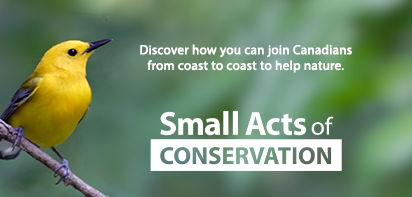Seven Days in Nature
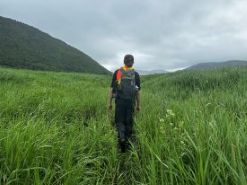
NCC intern Colin Decoste trudging through tall grass in the Grasses Nature Reserve. Photo by Jennifer Sullivan (NCC staff)
As the sun slowly rose, its golden light shone over the twin mountains that stand guard on either side of the river. Gentle bird calls flooded the air, and a breeze rustled the leaves of the nearby trees. This beautiful sight, according to Nature Conservancy of Canada (NCC) intern Colin DeCoste, was the best part of a week of field work on the remote Grasses Nature Reserve.
NCC’s Grasses Nature Reserve is the largest nature reserve in Newfoundland and Labrador. Located in southwestern Newfoundland, its 1,570 hectares are situated along the most northerly extension of the Appalachian Mountains.
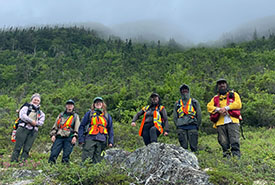
The research team geared up and ready to trek. Photo by Madeline Sceviour (NCC Intern)
In July 2024, Colin and fellow interns Emily Stevens and Madeline Sceviour ventured out onto the Grasses Nature Reserve. They were accompanied by three full-time NCC staff members and a PhD student from Memorial University who was conducting research on lichens. The team spent weeks planning and packing meticulously, as they would remain deep in the Grasses for an entire week. Once there, they had almost no communication with the outside world, and had only each other for company.
The team set up their camp on a grassy outcrop on the edge of the river that runs through the Grasses. From their campsite, they could see the mountains, the river and the grassy meadows that give the reserve its name.
“I haven’t been anywhere else in Newfoundland that looked like that,” says Madeline. The view was picture-perfect, but sightseeing was low on their list of tasks for the week.
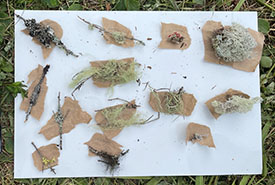
A layout of some of the lichens the team observed on the reserve. Photo by Madeline Sceviour (NCC intern)
The primary purpose of the Grasses expedition was to check on the status of its various ecosystems. This type of work is common for NCC interns across the Atlantic provinces. Over the summer, the three interns in Newfoundland monitored NCC nature reserves across the island for signs of rare and invasive species, as well as unauthorized human activity. Their efforts were crucial in determining what additional conservation work needs to be done to maintain the health of natural landscapes in Atlantic Canada.
For example, about 40 years ago, many of the trees in one section of the Grasses Nature Reserve were killed due to an infestation of two insects: spruce budworm and hemlock looper. The infestation itself is natural, but the region’s abundant moose had been eating the tree saplings and stunting their growth. The areas of stunted trees, called “moose meadows,” appear as grassy fields.
“Part of our trip this year was to assess the regeneration of these moose meadows by measuring changes in the canopy coverage,” explains Colin.
Each day, the team split up into groups across the nature reserve. Their adventures took them up into the mountains and down into rivers with splashing fish. One day, Madeline and Emily explored a part of the nature reserve where the grassy meadows and forest gave way to a field of boulders. Wrapped in a blanket of thick moss, the boulders were slippery and forced the interns to tread carefully.
One small slip revealed a stream of very cold air inside the deep cracks between the boulders. Peering into the cracks, Madeline discovered a strange species of lichen. The PhD student, and the team’s resident lichen expert, later identified it as Arctic kidney lichen, a species that normally grows only in the Arctic.
“There were just so many pockets of different micro-climates across the entire property,” Emily says. Such a vast and diverse landscape enables many different species to flourish. The team spotted at-risk plants like ragged fringed orchid, yellow rattle, arctic raspberry, net-veined willow and endangered Appalachian matchsticks lichen. They also identified several at-risk bird species, including great blue heron, rusty blackbird and olive-sided flycatcher. Knowing what species reside on the Grasses will help them better understand the ecosystems there, so they can care for the land effectively.
Perhaps the most daunting beast they encountered in the Grasses was the hot sun. Trekking up and down the nature reserve in temperatures over 30 C would have been a challenge even without the hundreds of mosquitoes that seemed to follow the team everywhere.
Despite their hardships, the team made sure to have a bit of fun. Each hard day of work ended with a splash in the river. Their daily swim was another favourite memory from their trip, surpassing silly jokes told over walkie talkies and in-depth conversations held in the larger communal tent.
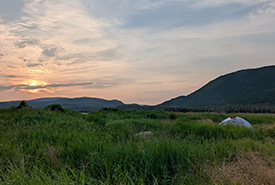
Stunning sunset over the campsite. Photo by Emily Stevens (NCC intern)
It seemed that all too quickly, six nights of camping in the heart of nature came to an end. The team packed up their tents and left the Grasses. Behind them, the twin mountains looked down on the river, and the grassy meadows rustled quietly in the wind.
Alone once more, the Grasses Nature Reserve waits patiently for the next time a monitoring team journeys onto its spectacular landscape.
Thank you to Cenovus Energy for helping to fund NCC’s internship program in Newfoundland and Labrador.



